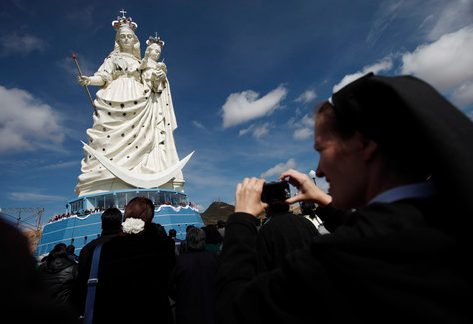
(above) A nun takes pictures of a newly unveiled statue of the Virgin Mary holding a baby Jesus on Santa Barbara hill in the mining city of Oruro, Bolivia, Friday, Feb. 1, 2013. The 45 meter (147 feet) statue that took four years to build, known in Spanish as "Virgen del Socavón," or the Virgin of the Tunnel, is Oruro's patron, venerated in particular by miners and folkloric Carnival dancers. (AP Photo/Juan Karita)
Bolivia mining town erects huge statue of Virgin
February 2, 2013 - NewsLeader (AP)
ORURO, Bolivia (AP) -- The Carnival celebrations in this Andean mining city already rival Brazil's Rio de Janeiro for color and culture, if not for size. Now Oruro has erected a huge statue of the Virgin Mary that's a little taller than Rio's famed Christ the Redeemer.
(below) Pilgrims holding candles pray at the base of the statue of the Virgin Mary on Santa Barbara hill before sunrise in the mining city of Oruro, Bolivia, Friday, Feb. 1, 2013. The statue, known in Spanish as "Virgen del Socavón," or the Virgin of the Tunnel, is Oruro's patron, venerated in particular by miners and folkloric Carnival dancers. The statue was unveiled on Friday to mark the start of Carnival in Oruro, which coincides with celebrations honoring the Virgin that starts on Saturday, Bolivia's largest religious event. (AP Photo/Juan Karita)
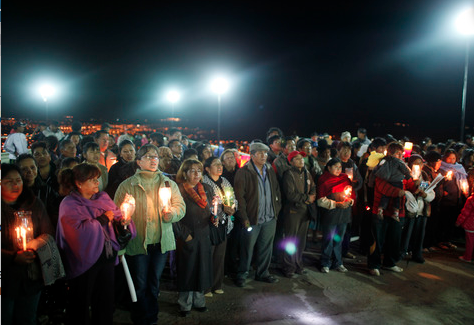
Oruro formally dedicated the new statue Friday as it kicked off its Carnival celebrations, which have been recognized as part of the patrimony of humanity by UNESCO.
(below) People watch the unveiling of a statue of the Virgin Mary holding a baby Jesus as flares are fired on Santa Barbara hill in the mining city of Oruro, Bolivia, Friday, Feb. 1, 2013. The 45 meter (147 feet) statue of Mary that took four years to build, known in Spanish as "Virgen del Socavón," or the Virgin of the Tunnel, is Oruro's patron, venerated in particular by miners and folkloric Carnival dancers. (AP Photo/Juan Karita)
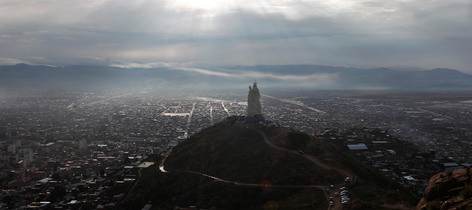
The Virgin of Socavon is almost 150 feet (45 meters) high -- a shade shorter than New York's Statue of Liberty and 23 feet (seven meters) higher than Rio's image of Christ. It's built of cement, iron and fiberglass to withstand the fierce winds of the high plain.
(below) A large statue of the Virgin Mary stands on Santa Barbara hill overlooking the mining city of Oruro, Bolivia, as it is unveiled on Friday, Feb. 1, 2013. The statue, known in Spanish as "Virgen del Socavón," or the Virgin of the Tunnel, is Oruro's patron, venerated in particular by miners and folkloric Carnival dancers. To withstand Bolivia's high plains' strong winds, the statue that stands at 45 meters (147 feet) was constructed with cement, metal and fiberglass. (AP Photo/Juan Karita)
"If Rio has its Christ and its Carnival, Oruro has its Carnival, and now it has the Virgin. We're complete," said Virginia Barrios, a neighborhood leader.
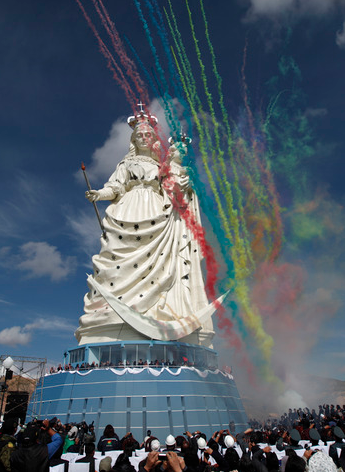
(below) Pilgrims stand at the base
of the statue of the Virgin Mary on
Santa Barbara hill as the sun begins
to rise in the mining city of Oruro, Bolivia,
Friday, Feb. 1, 2013. The statue,
known in Spanish as "Virgen del Socavón,"
or the Virgin of the Tunnel, is Oruro's
patron, venerated in particular by
miners and folkloric Carnival dancers.
The statue was unveiled on Friday
to mark the start of Carnival in Oruro,
which coincides with celebrations
honoring the Virgin that starts on
Saturday, Bolivia's largest religious
event. (AP Photo/Juan Karita)
She said construction of the statue cost $1.2 million and took four years.
(below) Musicians play during the unveiling of the Virgin Mary holding a baby Jesus on Santa Barbara hill in the mining city of Oruro, Bolivia, Friday, Feb. 1, 2013. The statue, known in Spanish as "Virgen del Socavón," or the Virgin of the Tunnel, is Oruro's patron, venerated in particular by miners and folkloric Carnival dancers. The statue was unveiled on Friday to mark the start of Carnival in Oruro, which coincides with celebrations honoring the Virgin that starts on Saturday, Bolivia's largest religious event. The city's carnival dates back to pre-Hispanic times, but it was during the colonial period that it became well known when, as legend has it, the image of the Virgin Mary revealed herself to a devotee who had been mortally wounded in a street fight. (AP Photo/Juan Karita)
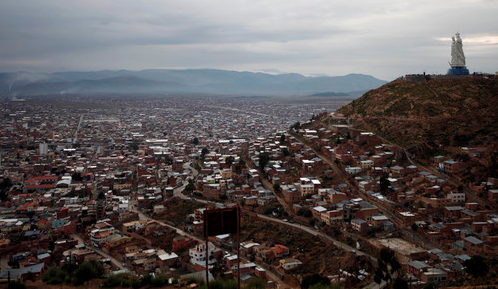
During Carnival each year, more than 30,000 people dance in procession through the streets, some in elaborate costumes, and brass bands blare. They honor the Virgin of Socavon, the patron saint of the city of roughly 250,000 people.
(below) Pilgrims holding candles pray at the base of the statue of the Virgin Mary on Santa Barbara hill before sunrise in the mining city of Oruro, Bolivia, Friday, Feb. 1, 2013. The statue, known in Spanish as "Virgen del Socavón," or the Virgin of the Tunnel, is Oruro's patron, venerated in particular by miners and folkloric Carnival dancers. The statue was unveiled on Friday to mark the start of Carnival in Oruro, which coincides with celebrations honoring the Virgin that starts on Saturday, Bolivia's largest religious event. (AP Photo/Juan Karita)
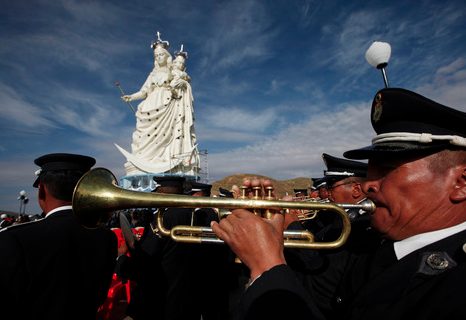
President Evo Morales, who was a musician in Oruro in his youth, participated in the inauguration of the statue and Pope Benedict XVI sent a message of blessing.